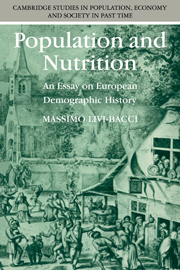Crossref Citations
This Book has been
cited by the following publications. This list is generated based on data provided by Crossref.
Kearns, Gerry
1992.
Historical geography.
Progress in Human Geography,
Vol. 16,
Issue. 3,
p.
406.
Fogel, Robert William
1993.
New Sources and New Techniques for the Study of Secular Trends in Nutritional Status, Health, Mortality, and the Process of Aging.
Historical Methods: A Journal of Quantitative and Interdisciplinary History,
Vol. 26,
Issue. 1,
p.
5.
Landry, Yves
1993.
Fertility in France and New France: The Distinguishing Characteristics of Canadian Behavior in the Seventeenth and Eighteenth Centuries.
Social Science History,
Vol. 17,
Issue. 4,
p.
577.
Pitkänen, Kari J.
and
Mielke, James H.
1993.
Age and sex differentials in mortality during two nineteenth century population crises.
European Journal of Population / Revue européenne de Démographie,
Vol. 9,
Issue. 1,
p.
1.
Johansson, S. Ryan
1994.
Food for Thought: Rhetoric and Reality in Modern Mortality History.
Historical Methods: A Journal of Quantitative and Interdisciplinary History,
Vol. 27,
Issue. 3,
p.
101.
VASEY, DANIEL E.
1996.
population regulation, ecology, and political economy in preindustrial Iceland.
American Ethnologist,
Vol. 23,
Issue. 2,
p.
366.
Dobson, Andrew P.
and
Carper, E. Robin
1996.
Infectious Diseases and Human Population History.
BioScience,
Vol. 46,
Issue. 2,
p.
115.
Zurbrigg, Sheila
1997.
Did Starvation Protect from Malaria? Distinguishing between Severity and Lethality of Infectious Disease in Colonial India.
Social Science History,
Vol. 21,
Issue. 1,
p.
27.
Murray, John E.
1997.
Standards of the Present for People of the Past: Height, Weight, and Mortality among Men of Amherst College, 1834–1949.
The Journal of Economic History,
Vol. 57,
Issue. 3,
p.
585.
Campbell, Cameron
1997.
Public Health Efforts in China before 1949 and Their Effects on Mortality: The Case of Beijing.
Social Science History,
Vol. 21,
Issue. 2,
p.
179.
Murray, John E.
1997.
Standards of the Present for People of the Past: Height, Weight, and Mortality among Men of Amherst College, 1834–1949.
The Journal of Economic History,
Vol. 57,
Issue. 3,
p.
585.
Luckin, Bill
and
Mooney, Graham
1997.
Urban history and historical epidemiology: the case of London, 1860–1920.
Urban History,
Vol. 24,
Issue. 1,
p.
37.
Lavely, William
and
Wong, R. Bin
1998.
Revising the Malthusian Narrative: The Comparative Study of Population Dynamics in Late Imperial China.
The Journal of Asian Studies,
Vol. 57,
Issue. 3,
p.
714.
Bowman, Alan K.
Garnsey, Peter
and
Rathbone, Dominic
2000.
The Cambridge Ancient History.
Andreau, J.
2000.
The Cambridge Ancient History.
p.
769.
2000.
The Cambridge World History of Food.
p.
617.
2000.
The Cambridge World History of Food.
p.
1379.
Garnsey, Peter
2000.
The Cambridge Ancient History.
p.
679.
Fauve-Chamoux, Antoinette
2000.
The Cambridge World History of Food.
p.
626.
Hedenborg, Susanna
2000.
The world is full of sorrow:.
Scandinavian Economic History Review,
Vol. 48,
Issue. 1,
p.
64.





